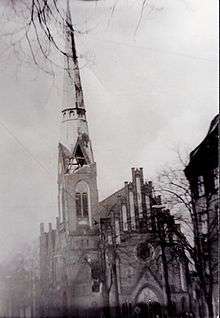Cyclone Quimburga
| Type |
European windstorm Extratropical cyclone |
|---|---|
| Formed | 11 November 1972[1] |
| Dissipated | Unknown |
| Lowest pressure | 953 mb (28.1 inHg)[2] |
| Highest gust | 245 km/h (152 mph)[1] |
| Casualties | 54[3][4] |
| Areas affected | Newfoundland, British Isles, France, Germany, Netherlands, Belgium, Italy, Switzerland, Austria, Denmark, Poland |
Cyclone Quimburga, also referred to as the Lower Saxony Storm[5] was a deadly European windstorm that struck northern and central Europe between 12–14 November 1972.[1] The storm has been described as one of the most devastating storm events during the 20th century.[5] The storm also destroyed the Königs Wusterhausen Central Tower, a 243 m (797 ft) communications tower to the southwest of Berlin [6] and the church steeple in Berlin-Friedrichshagen.

Damaged steeple of St. Christopher Church in Berlin-Friedrichshagen (Germany)
The Royal Netherlands Meteorological Institute headquarters in De Bilt has a courtyard which features a representation of the pressure map of the Quimburga storm.[7]
References
- 1 2 3 "Niedersachsen-Orkan 1972". Saevert. Retrieved 12 February 2012.
- ↑ "De storm van 13 november 1972" (PDF) (in Dutch). KNMI. Retrieved 19 March 2012.
- ↑ "54 Dead as Gale Winds Rake Europe, British Isles". The Milwaukee Sentinel. 14 November 1972. Retrieved 12 February 2012.
- ↑ "Storm 1972" (in Dutch). meteotuitjenhorn. Retrieved 19 March 2012.
- 1 2 Donat, Markus G.; Gregor C. Leckebusch; Simon Wild; Uwe Ulbrich (9 December 2010). "Benefits and limitations of regional multi-model ensembles for storm loss estimations" (PDF). Climate Research. 44: 211–225. doi:10.3354/cr00891. Retrieved 19 March 2012.
- ↑ "Mittelturm Königs Wusterhausen". skyscraperpage.com. Retrieved 19 March 2012.
- ↑ "Virtual tour: Look around at KNMI". KNMI. Retrieved 5 February 2013.
This article is issued from Wikipedia - version of the 9/20/2016. The text is available under the Creative Commons Attribution/Share Alike but additional terms may apply for the media files.
